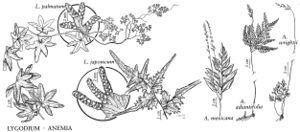familyLygodiaceae
Show Lower Taxa
Difference between revisions of "Lygodiaceae"
Common names: Climbing Ferns
Treatment appears in FNA Volume 2. Treatment on page 114.
FNA>Volume Importer |
FNA>Volume Importer |
||
| Line 13: | Line 13: | ||
}}<!-- | }}<!-- | ||
| − | --><span class="statement" id="st- | + | --><span class="statement" id="st-undefined" data-properties=""><b>Plants </b>terrestrial. <b>Stems</b> subterranean, protostelic; indument of dark, dense hairs. <b>Leaves</b> vinelike, of indeterminate growth. <b>Pinnae</b> reduced to short stalks, each bearing a pair of opposite pinnules, usually with an often dormant apical bud. <b>Sporangia</b> in 2 rows, 1 on each side of midvein of contracted, oblong, marginal lobes of ultimate segments, covered by hoodlike flap of tissue serving as indusium. <b>Spores</b> tetrahedral-globose, trilete, rarely monolete. <b>Gametophytes</b> terrestrial, cordate, glabrous.</span><!-- |
-->{{Treatment/Body | -->{{Treatment/Body | ||
| Line 39: | Line 39: | ||
|publication year= | |publication year= | ||
|special status= | |special status= | ||
| − | |source xml=https://jpend@bitbucket.org/aafc-mbb/fna- | + | |source xml=https://jpend@bitbucket.org/aafc-mbb/fna-data-curation.git/src/9216fc802291cd3df363fd52122300479582ede7/coarse_grained_fna_xml/V2/V2_121.xml |
| − | |||
| − | |||
| − | |||
| − | |||
| − | |||
| − | |||
| − | |||
| − | |||
| − | |||
| − | |||
| − | |||
| − | |||
| − | |||
| − | |||
| − | |||
| − | |||
| − | |||
| − | |||
| − | |||
| − | |||
| − | |||
}}<!-- | }}<!-- | ||
-->[[Category:Treatment]] | -->[[Category:Treatment]] | ||
Revision as of 14:11, 27 July 2019
Plants terrestrial. Stems subterranean, protostelic; indument of dark, dense hairs. Leaves vinelike, of indeterminate growth. Pinnae reduced to short stalks, each bearing a pair of opposite pinnules, usually with an often dormant apical bud. Sporangia in 2 rows, 1 on each side of midvein of contracted, oblong, marginal lobes of ultimate segments, covered by hoodlike flap of tissue serving as indusium. Spores tetrahedral-globose, trilete, rarely monolete. Gametophytes terrestrial, cordate, glabrous.
Distribution
Tropical regions nearly worldwide and temperate regions of North America and Asia, s Africa, Pacific Islands in New Zealand.
Discussion
Genus 1, species ca. 40 (3 species in the flora).
Selected References
None.
Lower Taxa
... more about "Lygodiaceae"
